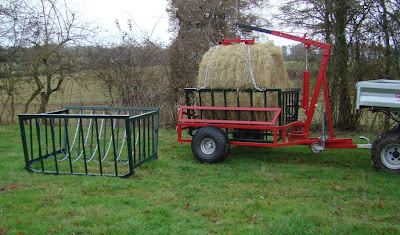Recently I have been very busy improving our hay delivery system for the sheep when they are outside in the fields.We wanted to be able to keep the sheep outside for the majority of the winter but at the same time make sure our fields were not damaged. Normally a tractor would carry the bales of hay to the sheep, but the fields become very soft in the winter and a tractor would leave ruts and ruin the soil structure. To avoid this, we have upgraded to a more powerful quad to help. This one has what is called hydrostatic drive - four seperate hydraulic motors, one on each wheel, which means it does not need to have brakes or a gearbox or the normal transmission equipment.
I have also made four hay racks and a special trailer to carry the hay out to the field already inside a hay rack. The crane on the front of the trailer can pick up a hay rack full of hay and we can then transport it securely wherever we want it behind the quad without damaging the fields, even when it has been raining.





